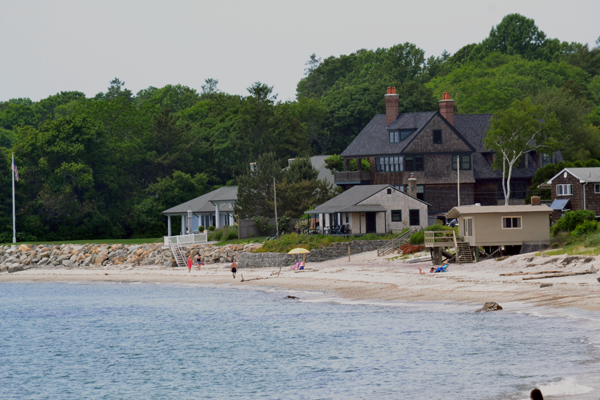Erosion of Connecticut’s Beaches and Dunes
Beaches and dunes are dynamic coastal features and are affected by short and long term changes in waves, wind, tides, storm surge, sand availability and sea level rise. These changes may be seasonal, episodic or storm-related, or slow, barely noticeable over many years. Storm impacts occur over a very short period but recovery of the beach may occur with seasonal changes or over a much longer period of time. In the case of severe storms, recovery of the beach may not occur at all.
Sea level rise has been impacting the Connecticut shoreline for centuries. Rates of sea level rise have been accelerating in recent decades along parts of the eastern United States. Sea level rise adversely impacts beaches that are bordered by infrastructure such as roads, homes and rail lines.
What is Erosion?
Erosion is a natural process and occurs when soil, sand or rocks are transported from one location to another through wind and wave forces. Coastal erosion and associated flooding can damage property and infrastructure. Erosion also compromises the ability of beaches and dunes to protect neighboring property, provide habitat for plants and wildlife, and accommodate recreational uses.
What Causes Erosion?
Erosion in Connecticut is generally caused by storms, rising sea levels, changes in sand availability, and is exacerbated by the construction of jetties, groins and seawalls. Sand availability can change when sand is moved offshore during storms and is no longer available for beaches, or when sand transported landward during storms is removed as debris. Erosion may also be caused by stormwater runoff from the adjacent uplands and solutions to this type of erosion will likely be different than those discussed here.
Beaches may be highly erosional, moderately erosional or slightly erosional. Beaches in Maine are considered highly erosional if they erode at a rate of more than two feet per year. In Maryland, shorelines that experience at least 4 feet of erosion per year are considered to have moderate to high erosion. According to a 1999 report, 9% of Connecticut’s shoreline is considered critically eroding.
Structures may exacerbate erosion issues on beaches. Many highly erosional beaches have seawalls or revetments that protect the land behind them, but can lead to increased erosion of the beach in front of the wall. Seawalls and revetments can also cause erosion on neighboring beaches since the wall interferes with the movement of sand alongshore. Most highly erosional beaches are in need of sand replenishment to replace eroded sand since many highly erosional shorelines have no beach for about half or all of the tidal cycle.
Moderately erosional beaches in Connecticut have erosion rates of one to two feet per year. Natural beaches in this category have chronic dune scarps (steep drop-offs) and frontal dune erosion. Some beaches have exposed gravel berms and reduced recreational opportunities at high tide. As above, structures may increase erosion on these beaches. Along some of these beaches where seawalls are present, the seawalls are regularly overtopped during winter coastal storms, and have been undermined during severe coastal storms. In other areas, local overtopping occurs once or twice a year in winter, but is usually restricted to limited areas of beachfront properties.
Slightly erosional beaches have rates of erosion that are less than one foot per year. Of greatest concern for these beaches may be sea level rise over time.
Types of Erosion

Beach in Waterford, Connecticut.
Photo: Jennifer O'Donnell